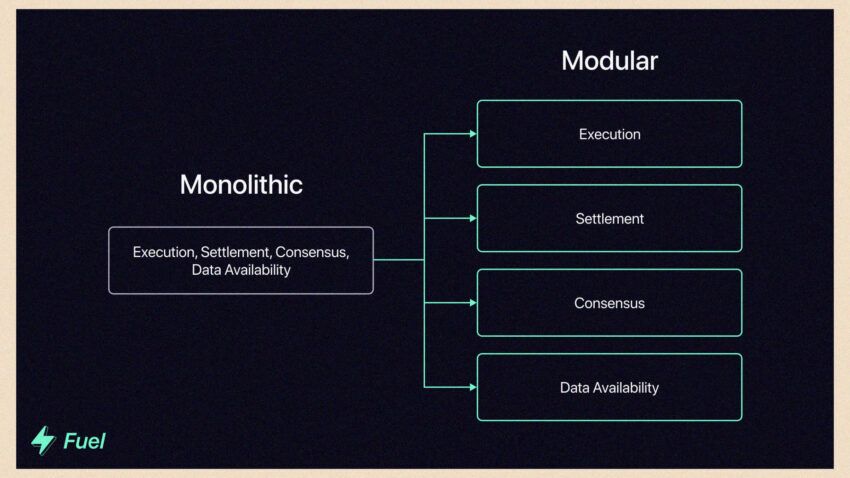The most popular blockchains, including Bitcoin and Ethereum, can be identified as layer-1’s. But other layers also exist within increasingly diverse decentralized ecosystems. The layer-0 blockchain brings a new element of innovation to the space.
While a layer-1 blockchain focuses on implementing the consensus mechanism, layer-0 is all about facilitating cross-chain interoperability. This guide covers everything you need to know.
- What is a layer-0 blockchain?
- Understanding the blockchain hierarchy better
- Key features of layer-0 blockchains
- Technical foundations of the layer-0 chains
- What are some top layer-0 blockchains?
- Practical applications of layer-0 chains
- What’s the future of the layer-0 blockchain ecosystem?
- Frequently asked questions
What is a layer-0 blockchain?
Blockchains are hierarchical. While the layer-1s came first, in the form of Bitcoin and Ethereum, scaling them required layer-2 chains. Eventually, layer-3 blockchains came into existence, hosting DApps and specialized projects. However, layer-0, per the name, is more like the Zeroth law of Thermodynamics, pushed before the layer-1 chains due to their fundamental existence.
Simply put, layer-0 chains combine technologies and protocols underpinning the blockchain ecosystem. The layer itself includes networking protocols, physical hardware, and other elements to improve security and scalability. For the efficient operation of layer-1 and layer-2 chains, layer-0 blockchains are necessary.
Let us understand the concept a bit better with a real-world example, say, of a city. You can consider the big, expansive city infrastructure as a layer-0 blockchain, with the layer-1 chains being the buildings. Layer-0 blockchain or the city infrastructure houses the water pipes, electrical grids, and more — all interoperable systems.
These chains also focus on solving the blockchain trilemma by offering solutions that are secure, decentralized, and even scalable. In the context of the city, consider this to be a scenario where you get secure communication and efficient traffic flow — all without hindering the availability of essential services throughout.
Understanding the blockchain hierarchy better
While we did discuss the basic hierarchy using a city-based analogy, let’s dive a little deeper into the technical elements. We shall now list the layers and focus on their roles in the blockchain space.
Layer-0: This is a foundational layer offering the basic blockchain technology infrastructure, including hardware, software, and protocols. The role of layer-0 is to act as a bedrock, offering connectivity solutions for the layer-1 chains to work seamlessly, enabling cross-chain interoperability, and more.
Layer-1: This is the blockchain layer where smart contracts, consensus mechanisms, and security implementations thrive. These chains support proof-of-work, proof-of-stake, and other consensus mechanisms and work as the visible part of the blockchain ecosystem. Layer-1 chains actually process transactions and must achieve a balance between scalability and transaction speeds.
Layer-2: These are specialized scaling solutions that are meant to ease out the transaction limitations associated with layer-1 chains. They borrow their security posture from the layer-1 chains and are meant to eliminate network congestion. Some examples of layer-2 crypto projects include the Bitcoin Lightning Network, Optimism, and Arbitrum.
Apart from the mentioned layers, layer-3’s are also a credible blockchain technology, primarily responsible for offering specialized services.
Key features of layer-0 blockchains
Let us now take a closer look at the specific traits of the layer-0 blockchains.
Foundational infrastructure
As mentioned previously, layer-0 chains offer the infrastructural stability to a sizable blockchain setup, offering protocols, software modules, and other solutions — even for layer-1 chains to build on top of.
/Related
More ArticlesModular framework
The elements of layer-0 blockchains are modular, allowing developers to develop novel consensus algorithms and networking protocols. The element of modularity also lets the developers improve and even replace the blockchain set pieces based on requirements.

Protocol agnosticism
Layer-0 chains are designed to work as plug-and-play elements, with zero to minimal dependency on other protocols and layers. It is this flexibility that makes layer-0 chains the foundational elements.
Cross-chain interoperability
With layer-0 chains, builders and developers create services that can cross-interact between chains and protocols. From seamless information sharing to enhancing the vision of one-chain-for-all, layer-0 makes all that possible.
Handling the blockchain trilemma
A layer-0 chain has a special way of tackling the issues concerning blockchain trilemma. Here is how the same works. Firstly, as layer-0 allows several layer-2 chains to operate, even while facilitating off-chain transactions, a large volume of data can be managed, thereby ticking off the scalability box.

Also, as a base layer, layer-0 chains are inherently secure and, therefore, take care of the existing blockchain vulnerabilities. Finally, as layer-0 chains allow multiple blockchain networks to coexist and work together, the decentralization element is also present.
All these features and traits make layer-0 chains extremely popular and desirable, supporting blockchain technology’s expansion and development.
Technical foundations of the layer-0 chains
Even though consensus mechanisms, smart contracts, and transaction processing are usually the elements associated with layer-1 chains, they can also be incorporated into layer-0 chains, owing to their modular structure.
From proof-of-work to proof-of-stake to other consensus mechanisms, layer-0 chains can be primed to include these elements for later working as independent layer-1 solutions. This is why a network like Polkadot qualifies as both a layer-0 and layer-1 chain.

Besides the consensus mechanism integration, layer-0 chains can also be trained to include smart contracts, advanced blockchain protocols, and more.
Did you know? Even layer-0 chains can help improve transaction speeds. For instance, a layer-0 network, Cosmos, supports the concept of sidechain via zones and hubs to handle network congestion.
What are some top layer-0 blockchains?
Now that we have some idea as to how a layer-0 chain works, let us take a closer look at the examples, their use cases, and unique traits:
Polkadot
Arguably the most popular layer-0 chain, Polkadot brings a multi-chain or, rather, the Parachain approach to the table. Plus, it uses the Nominated proof-of-stake consensus, whereas validators — individuals who secure the network — are chosen based on the amount they are staking.
Besides the parachain network, Polkadot has a unique Relay Chain for finalizing transactions. As for the record, Polkadot aims to create other layer-1 chains built using parachains, all while facilitating a heterogeneous framework.
Cardano
Even though we know Cardano to be a popular layer-1 blockchain, its underlying infrastructure can qualify it as a layer-0 chain. Its Ouroboros proof-of-stake consensus mechanism is made of slots and epochs, allowing the chain to work as a foundational layer-0 network.
Cosmos
This chain features the Tendermint consensus mechanism, which is a variation of the PoS algorithm.
“As a layer-0, the success of Cosmos relies on the success of projects in the ecosystem. Terra was one of these and led to TVL on Cosmos skyrocketing earlier this year, with Terra making up 90% of Cosmos TVL.”
Conor Ryder, Head of Research at Ethena Labs: X
In regards to functionality, Cosmos is termed the “Internet of Blockchains,” allowing different chains to communicate and keeping the interoperability quotient in play.
Want to know more about the Internet of Blockchains and its native coin, ATOM? Check out our guide covering how to buy Cosmos and everything you need to know.
Harmony
Here is one of the lesser-known layer-0 chains that bring in Random State Sharding for handling the transaction speed use-case. Harmony helps with scalability despite being a layer-0 or the foundational layer. Regarding the consensus mechanism, the network features EPoS, or the Effective proof-of-stake, to combat centralization.
Besides the popular names, there are some other layer-0 networks around, including Substrate — a part of Polkadot’s ecosystem; Marlin Protocol — meant for creating high-performance networks; and more.
Practical applications of layer-0 chains
Nothing fits unless we know how a specific component of the blockchain technology works. Well, here are the practical examples of layer-0 chains, which make them popular and sought-after:
DeFi: Chains like Cosmos have a decent DeFi presence as they support cross-chain transactions, have the ability to transact seamlessly, keep financial services in mind, and more.
Supply chain: Layer-0 chains can be a handful when supply chain management is concerned. The scalability on offer is the reason why these networks are preferred for supply chain and logistics.
Healthcare: With the focus on interoperability and security, Layer-0 chains can be useful for managing and maintaining patient records.
While these are some of the use cases, layer-0 chains can also be used for public services, including the creation of identity verification metrics, voting systems, and record management tools.
What’s the future of the layer-0 blockchain ecosystem?
A lot is going on in the layer-0 blockchain space. With Metallicus developing a new layer-0 chain that adheres to regulatory standards, focusing on banks, global firms, and more, the future looks optimistic and primed for inclusive developments. Additionally, with the layer-1 restrictions continuing to exist and layer-2s often grappling with security concerns, the focus might shift to layer-0 blockchains for on-chain development in the future.
Frequently asked questions
What are the examples of layer-0 blockchains?
Is Bitcoin a layer-0 blockchain?
Is Polkadot a layer-0?
Is Ethereum layer-0 or layer-1?
Trusted
Disclaimer
In line with the Trust Project guidelines, the educational content on this website is offered in good faith and for general information purposes only. BeInCrypto prioritizes providing high-quality information, taking the time to research and create informative content for readers. While partners may reward the company with commissions for placements in articles, these commissions do not influence the unbiased, honest, and helpful content creation process. Any action taken by the reader based on this information is strictly at their own risk. Please note that our Terms and Conditions, Privacy Policy, and Disclaimers have been updated.





